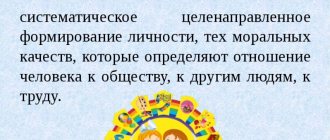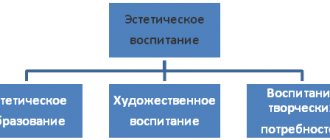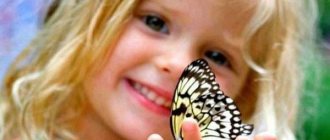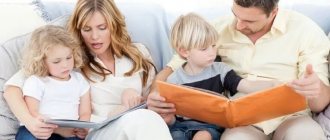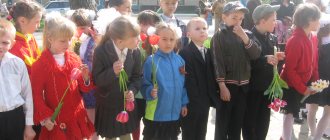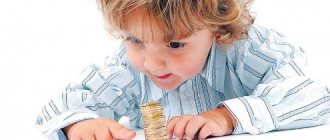Purpose of music education in preschool educational institutions
Definition 1
Musical education is a specially organized process of influence through the means of musical art, through which the aesthetic development of a child is realized, the foundations of his general culture are formed, and value guidelines are developed.
Musical education has a positive impact on personal development.
Music influences the formation of the creative component of the individual and contributes to the development of the creative foundations of his activity. and this, in turn, leads to the harmonious development of the child and the formation of all his qualities necessary for successful social life.
The main purpose of music education is the comprehensive harmonious development of the child’s personality. A number of subgoals of music education can be distinguished:
Are you an expert in this subject area? We invite you to become the author of the Directory Working Conditions
- Introducing a preschooler to the art of music. The child learns the basics of musical creativity, learns the aesthetic perception of music, and develops musical taste.
- Mastering the fundamentals of musical culture. Through it, the child learns the basics of general culture and forms his own views, attitude towards art, and develops his own line of cultural behavior.
- Development of musical abilities of a preschooler. Through musical education, a sense of rhythm, musical memory, auditory attention and perception are formed, which ultimately contributes to the formation of musical taste.
- Formation of the need for music. The need for musical creativity leads to the creative development of a preschooler.
- Implementation of different types of musical and artistic creativity of preschool children. In this way, the child can assert himself and realize himself in a creative direction, satisfy his creative needs.
Music classes in preschool educational institutions are aimed at developing in preschoolers a love of music, an interest in art, and the development of adequate musical taste and orientation skills in musical information.
Finished works on a similar topic
Course work Musical education of preschool children in preschool educational institutions 400 ₽ Abstract Musical education of preschool children in preschool educational institutions 230 ₽ Test work Musical education of preschool children in preschool educational institutions 200 ₽
Receive completed work or specialist advice on your educational project Find out the cost
Music education program according to the Federal State Educational Standard
Let's start with the fact that now there are various programs designed to develop musical performances and built on the basis of the Federal State Educational Standard. There is no single recognized author here, so the teacher is free to choose what suits him best or combine several options.
It is important! FSES – Federal State Educational Standard. Defines all those abilities, skills, knowledge that a student should receive at a certain stage of his development and in a specific subject or direction. In this case, preschool music education and training. It is developed at the state level, approved by the federal executive body and is mandatory and implementable.
The main thing is that the selected benefit fully complies with the requirements of the Federal State Educational Standard. The program will be different for each age group. The material gradually becomes more complex, becoming more capacious and at the same time voluminous. Children systematically and harmoniously receive the necessary ZUNs, learning to understand music.
Selection of lesson topics
The topics of music classes are determined by the current period of study. It should not be separated from the outside world, otherwise the principle of correspondence between the information received and what directly surrounds the child at the moment will be violated.
Topics may be related to:
- time of year or current month,
- state or national holiday,
- significant event in social life,
- a specific work;
- biography of the composer and his creations;
- some tool or new concept, etc.
This approach allows you to connect each lesson with the surrounding reality, expand the child’s understanding of the world, and implement the principle of relevance and practicality of learning. After all, “dead” knowledge is of no interest to anyone. They can only be brought to life by being included in the context of what is happening.
What tools to use?
In general, visualization and sensory perception play a huge role in children’s learning. As teachers and psychologists say, if the hand works, then the brain works. This means that the more real tools you can use, the better and more productive your learning will be.
One of the central things in the hall is, of course, the piano. An instrument that allows you to listen to the subtlest modulations of sounds and is excellent in solo performance. It has a truly magical power of influence on little listeners.
Very often tambourines, maracas, drums, and wooden spoons are used in classes. Firstly, they are accessible to children. Even a three-year-old child can try to play something on such an instrument. Secondly, they set the rhythm perfectly. And children really like this, it captures their entire being and takes them somewhere far away! Boys and girls are ready for various rhythmic exercises, perhaps, from birth.
Metallophones, bells, and triangles are suitable for organizing spring and autumn orchestras, in which the sound of rain and the ringing of drops will be heard. They sound very interesting, creating the effect of living nature. They also rightfully deserve special love from children.
Acquaintance with string instruments occurs through the balalaika or guitar. They are great for themed evenings, as well as musical accompaniment of performances. Finally, for variety, you can also use wind instruments, such as a trumpet or flute. The kids will be interested in them and try to make melodic sounds.
Do not forget that technology does not stand still. Today it is quite advisable to use synthesizers to create a more spacious, unusual sound. In addition, tape recorders and music centers are allowed in the garden so that children can listen to professional recordings and arrangements.
Recently, very often musical classes are combined with drawing with light or sand. This captivates the kids and expands the scope for creativity. You can choose a light tablet or table in the psychologist’s gaming tables section: light tablets for drawing with sand. Here you will also find a lot of additional equipment and stencils.
Examples of games and exercises for music classes
Music lessons are structured depending on the age of the child. The less, the simpler, more fun and shorter. Children of the younger group only have enough attention for 8-10, maximum 15 minutes. If you drag out activities, even constantly changing them, the child will get tired, and the teacher will not get any useful results.
The children in the middle group are already more disciplined and diligent. For them, the lesson plan becomes more complicated and the duration increases. Recommended time is 20 minutes. Moreover, it is already possible to include calmer, directly educational activities, to introduce them to the terminology and features of the subject.
Children of the older group are already fully adapted to being in kindergarten and can play according to strict rules. A musical lesson for them lasts no more than 25 minutes, the exercises become more complex and multifaceted. Preparators already have sufficiently developed voluntary attention. They can concentrate and complete complex tasks. In preparatory groups, the duration of any lesson is 30 minutes.
What activities should be included for each age?
Games for the younger group
In the younger group, all training takes place only in the form of games. You will never seat children of two or three years old at tables and force them to simply listen. No, the more active, the more fruitful. That is why classes are fun, relaxed, more like games. The child should perceive them as entertainment.
Story-based games with choruses work very well. For example, the very famous “Rain”. The music director and the children sing:
Rain, rain, more fun,
Drip, drip, don't regret it.
Sprinkle more in the field, the grass will become thicker.
Just don’t kill us, don’t knock on the window in vain.
After these words, the whole group runs away from the child pretending to be Rain. His task is to “wet the guys”, that is, to hurt them.
Games that require a lot of actions and imitation, for example, of animals or adults, not only appeal to children, but also bring great benefits, developing precision coordination and teaching kids to control their bodies.
For example, “The Bunnies and the Fox.”
Children, together with the teacher, sing together and perform the appropriate actions:
– Bunnies scattered across the forest lawn (they run in all directions, trying not to hit anyone). These are the bunnies, the running bunnies!
– The bunnies sat in a circle, digging a root with their paw (they squatted down, pretending to dig the ground). These are the bunnies, the running bunnies!
Here only the teacher comes in:
- Suddenly a fox runs, sly little sister! (“the little fox” runs flirtatiously between the “bunnies”).
- He’s looking for where the bunnies are, the running bunnies! (“the fox” rushes after the “bunnies”, who run away from her in all directions).
With younger children, it is advisable to learn funny folk dances, and only a few elements. For example, “let’s portray Petrushka” with characteristic dance movements or “let’s dance like nesting dolls”, also with an appropriate rhythmic pattern.
Moving, active musical numbers are more suitable for kids. Dances or dances in which the rhythm is clearly felt. Plus, with them you can learn short nursery rhymes like: “Andrew the Sparrow, don’t chase the pigeons!” Chase the ticks out from under the sticks!”
Exercises for the middle group
Children in the middle group have already developed more skills and abilities, their attention is more focused, although not as long as that of preschoolers. Jokes and nursery rhymes amuse such children, but are not particularly interested. The teacher should introduce more serious exercises, leaving a play element in each.
For example, the active game “Sun and Cloud” not only entertains children, but also teaches them to perceive musical tonality and determine whether the melody is set to a sad or cheerful one.
The gameplay is simple. The teacher explains that the weather outside is variable, and when it’s sunny, the children go for walks, and when it’s cloudy, they sit at home. Then he gives a task: to determine by the nature of the sounding music whether the sun or clouds have appeared in the sky? In accordance with the decision made, either “go for a walk”, i.e., run around the hall, or “stay at home”, i.e. sit on chairs. Next, different melodies are turned on, and the children follow the terms of the game.
At this age, it is especially fruitful to work with the integration of all senses and develop sensory skills. Children are taught to connect colors and sounds they hear. For example, the didactic game “Three Flowers” will be very useful (there may be more of them, depending on the level of training of the children.
The leader places three flowers in front of the group. These can be geometric shapes or any other images. The main thing is that they differ in color: red, green, blue. Then the teacher explains the condition. Music will be played, children should listen to it carefully, completely immersing themselves. The main task is to imagine which color corresponds to the melody and tell why this is so.
With an average group you can already learn complex, story-based songs. For example, “Katyusha”, “Winged swing”, “Three white horses”, etc. The children are captivated not only by the rhythmic patterns of the works, but also by the pictures that appear in the imagination. This is why it is better to choose songs in which something happens. And which are well known to children from the same cartoons or literature. And after the first listening, give the task to draw what was heard. Children love these exercises!
Lessons for the senior group
The older group is almost getting ready for school. With such guys, you can leave all the exercises as with the average one, only complicating them. The repertoire includes longer, melodic songs. Children learn to control their voices and try to hit difficult notes. At this age, it is advisable to give solo performances: songs, dances, instrumental performances. Playing in an orchestra is very suitable for team unity, when each child is responsible for a certain sound. And together everything merges not into cacophony, but into melody. Both boys and girls really like such activities. There is a pronounced playful element in them: the guys feel like real musicians!
What remains of the exercise is chanting, memorizing songs and dance numbers. You can include theatrical performances with musical accompaniment. Such performances look especially bright at matinees and cause sincere delight among parents. Plus, educational games are also in demand. For example, “fun gymnastics” with accelerated movements.
Crow: Kar, Kar, Kar! (children wave their arms and shout)
Wind: clap, clap, clap! (clap their hands in a certain rhythm)
Rain: drip, drip, drip! (slap their knees together)
Legs: slap, slap, slap! (pretends to be splashing through puddles)
Children: ha, ha, ha! (depict joy in the rain, wave their hands)
Moms: ah, ah, ah! (prop their heads with their hands and rock from side to side)
Rain: drip, drip, drip (slap their knees)
Cloud: bang, bang, bang (they stomp their feet loudly, imitating thunder).
There are a lot of movements in this exercise, and they gradually speed up, which amuses the children and also forces them to concentrate so as not to make mistakes and not lose their rhythm.
Forms of organizing music education in preschool educational institutions
Musical education in preschool educational institutions is implemented in the following forms:
- Musical lessons. They are educational musical activities. During music lessons, the child’s intellectual, moral, aesthetic and cultural development is carried out. Musical classes include different types and areas of musical activity: singing, playing instruments, dancing, listening to music of different genres, getting acquainted with the work of great composers, mastering musical literacy.
- Independent musical activity of preschool children. It is associated with children demonstrating their creative abilities. They need to be encouraged to do this. Children apply their musical knowledge and focus it on their interests and needs.
- Music in everyday life. Music is becoming an important component of all types of preschool activities. It permeates all routine moments of the day. For example, music turns on when children are charging, it accompanies the gameplay. Getting ready for a walk can be accompanied by singing, etc. In addition, the preschool educational institution organizes holidays that are accompanied by musical performances.
- Musical education in the family. It is important to establish interactions with parents and form a unified direction of musical education. If music accompanies all the routine moments of a preschooler in a preschool educational institution, then at home it should also accompany the child. For example, a mother can find out what music the teacher plays during exercise and use it. At night you can sing a lullaby, etc. It is important that music be a constant component of a child’s life. An episodic nature will not give the desired educational effect.
The purpose and objective of educational activities
The goal and task of educational activities is to instill in preschoolers an interest in art, the ability to understand musical information , genres, musical forms , and to contribute to the formation of artistic taste in children.
Educational activity is the main form of educational activity in kindergarten and the educational process is carried out through direct instruction. In everyday life, the indirect guidance of the music director , teacher , and parents in the musical education of children .
Direct teaching in everyday life is not completely excluded, but it should be limited. Any musical communication with a child should be built on joint activity, partnership, encouraging his initiative in every possible way, which is especially important when children exhibit independent musical expressions . Music in the everyday life of a kindergarten combines all forms of musical activity : holidays, entertainment, morning exercises.
So, the form of organizing music education in the everyday life of a kindergarten provides for two types of guidance from the teacher , music director , and parents: direct and indirect. During games, educational exercises, and walks, music can be played at the request of both children and adults.
But in entertainment, holidays, morning exercises, this happens, as a rule, on the initiative of the teacher; at the same time, he must, of course, take into account the capabilities, interests and passions of the children. The interaction of the entire teaching staff is one of the signs of a highly effective organization of the educational process.
The music director creates conditions for children to acquire knowledge, skills and abilities in various types of musical activities , and the teacher helps to consolidate them.
In order for music to become firmly established in children’s lives, the music director needs to build interaction not only with the team of teachers, but also with parents. To do this, certain work is carried out with parents, during which it is necessary to ensure that they become conductors of the child’s cultural formation. Children and adults love general forms of interaction , and these are holidays, entertainment, competitions, quizzes.
Club work also contributes to the emergence of independent musical activity in children, both in a group and at home with their parents. the accumulated musical experience into everyday life in accordance with his interests and desires.
The emergence of independent musical activity in kindergarten is one of the indicators of a high level of development of children, characterized by certain musical skills and abilities , the ability to transfer a variety of musical activities into everyday life.
The child must be able to apply the accumulated musical experience , developed musical skills and abilities in new conditions, in independent musical activities according to his interests and desires.
The structure of a music lesson in a preschool educational institution
Music classes at preschool educational institutions consist of the following components:
- Introductory part. It is aimed at preparing preschoolers to become familiar with music. In the introductory part of the lesson, you can include physical education components: performing movements to music, performing dance steps. This stimulates the preschooler’s musical activity and makes music lessons more productive.
- Listening to music. This part is focused on developing preschoolers’ skills in aesthetic perception of musical creativity and the formation of musical perception.
- Singing and song creativity. Children sing songs of different genres and also learn to compose songs on their own. Independent composing of a song motivates a preschooler’s interest in the art of music and helps to reveal his creative potential.
- Learning to play musical instruments. Typically, instruments are selected that are accessible to a specific age group. The teacher demonstrates their sound and shows the basics of playing melodies. Then the children themselves try to master playing this or that instrument.
- Dance activity. Dancing promotes the development of musical rhythm and creates a positive attitude towards music, because dancing is fun.
- Game activity. It is not a component of every music lesson, but may be included periodically. The game helps to absorb musical information more productively.
Types of musical activities
The standard defines age-appropriate activities, including musical activities for children.
In infancy (2 months - 1 year) - this is direct emotional communication with an adult, manipulation with objects and cognitive research activities, perception of music, children's songs and poems, motor activity and tactile-motor games.
At an early age (1 year - 3 years) - these are object-based activities and games with composite and dynamic toys, experimenting with materials and substances (sand, water, dough, etc.), communication with an adult and joint games with peers under the guidance of an adult, self-service and actions with household tools (spoon, scoop, spatula, etc.), perception of the meaning of music, fairy tales, poems, looking at pictures, motor activity.
For preschool children (3 years - 8 years) - this is a gaming activity, including role-playing games as the leading activity of preschool children, as well as games with rules and other types of games, communicative (communication and interaction with adults and peers), cognitive - research (studying objects of the surrounding world and experimenting with them), perception of fiction and folklore, self-service and basic household work (indoors and outdoors), construction from various materials, including construction sets, modules, paper, natural and other materials, visual arts (drawing, modeling, appliqué), musical (perception and understanding of the meaning of musical works, singing, musically rhythmic movements, playing children's musical instruments) and motor (mastery of basic movements) forms of activity of the child.
Based on the age-appropriate types of activities proposed by the Standard, it becomes possible to specify the forms of musical activity with children of early and preschool age (table). Please note that the proposed forms of a practice-oriented nature primarily grow out of the child’s cultural practices.
Conditions for the effective organization of music education in preschool educational institutions
In order for musical education to be productive, a number of conditions for its organization must be observed:
- Taking into account the age and individual characteristics of preschool children when planning a music lesson;
- Focus on the musical development of preschool children not only during music lessons, but in everyday life;
- The content of music classes should reflect the purpose of music education;
- The results of a preschooler’s musical development should be noticeable in the child’s daily activities - he transfers his knowledge and skills into his life activities;
- The teacher does not have an active educational influence on the musical development of the preschooler. The teacher identifies himself as an equal partner in joint musical activities, giving the child maximum independence in musical knowledge and development.
Get paid for your student work
Coursework, abstracts or other works
What are the benefits of music as an educational tool?
Songs and melodies are practically the only art form that children can properly appreciate at such a young age. Even in the first months of life, babies react to melodies and can express their feelings about what they hear with their emotions. Through a lullaby, an attitude towards loved ones and art is formed.
Important
It is important to make music accessible to such a young age. For preschoolers, it is very difficult to listen to, understand and evaluate a piece of music with a duration of more than 5-7 minutes. Children simply will not be able to sit for more time in attention; this must be taken into account when planning lessons.
To solve the problem, you need to select short fragments for listening with maximum ease of comprehension. It is better to take those parts and passages that are used on television for intros to programs, in films, and in theatrical productions. Their impact on the subconscious has already been tested for years and is highly likely to cause a strong emotional response, as well as maximum results in the musical education of preschoolers.
More diagrams on the topic “Music in kindergarten”.
Methods and techniques for musical education of preschool children
The following methods are used to form a musical culture:
- Contrastive comparison - a system of tasks has been developed that are based on listening to different interpretations of the same work. By contrast, students learn to understand the meaning of a work and break it down into its component parts.
- Assimilation to the character of the sound consists of an emotional adjustment to the sound and in expressing one’s attitude towards the works being listened to. Similarity can manifest itself in a variety of forms: singing along, dancing, choosing clothes, etc.
- Tactile assimilation - the teacher touches the child’s hand to set him up to listen to the musical playback for maximum insight into its essence.
- Mimic assimilation - when listening to works, children look at the teacher and expect his assessment of what is happening. To develop musical taste, you will need to show emotions that correspond to the nature of the work. For example, it is appropriate to smile, make a serious face, and show passion. Children in preschool age are subconsciously drawn to adults, copying their behavior and emotions.
- Intonation assimilation - when listening to compositions, you need to express your attitude in words and replicas. In preschool age, it is difficult for children to grasp the meaning of words, phrases or sentences if they explain the essence of the composition in difficult to understand language. Therefore, it is better to express your attitude to music in simple words that are understandable for children, but saturated with bright emotional coloring. They act directly on the subconscious, bypassing the stage of mental comprehension of what is heard.
- Color comparison - when listening to a composition, you need to show the students cards with colors and associate a certain color with the general mood of the work. For example, when listening to a calm composition, the color blue is shown; for an active and sound-rich song, you need to show the color red. When listening to subsequent melodies, you should ask the children what color this or that song is associated with.
Classes on theatrical activities in secondary groups of the Children's Center
Modern technologies in musical education of preschool children
A special approach in this area of education requires the use of innovative methods and technologies. Modern inventions facilitate and determine the variety of activities of a teacher.
Thus, when listening to melodic compositions, presentations and videos are widely used. Such visibility and expanded capabilities allow you to better perceive and understand information conveyed through music.
When learning dance movements and rhythmic exercises, videos on relevant topics are used.
These methods arouse greater interest in children and contribute to better development of musicality.
The accumulation of musical experience and culture is facilitated by the technology of development of music perception by O. P. Radynova.
